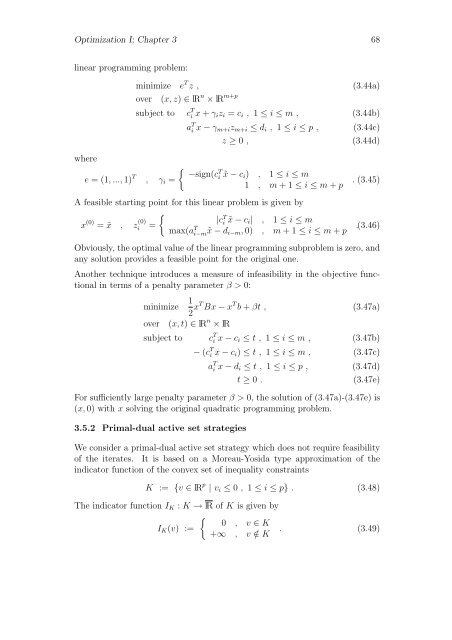Chapter 3 Quadratic Programming
Chapter 3 Quadratic Programming
Chapter 3 Quadratic Programming
Create successful ePaper yourself
Turn your PDF publications into a flip-book with our unique Google optimized e-Paper software.
Optimization I; <strong>Chapter</strong> 3 68<br />
linear programming problem:<br />
minimize e T z , (3.44a)<br />
over (x, z) ∈ lR n × lR m+p<br />
subject to c T i x + γ i z i = c i , 1 ≤ i ≤ m , (3.44b)<br />
a T i x − γ m+i z m+i ≤ d i , 1 ≤ i ≤ p , (3.44c)<br />
z ≥ 0 ,<br />
(3.44d)<br />
where<br />
e = (1, ..., 1) T , γ i =<br />
{ −sign(c<br />
T<br />
i ˜x − c i ) , 1 ≤ i ≤ m<br />
1 , m + 1 ≤ i ≤ m + p<br />
A feasible starting point for this linear problem is given by<br />
{<br />
x (0) = ˜x , z (0)<br />
|c<br />
i =<br />
T i ˜x − c i | , 1 ≤ i ≤ m<br />
max(a T i−m˜x − d i−m , 0) , m + 1 ≤ i ≤ m + p<br />
. (3.45)<br />
.(3.46)<br />
Obviously, the optimal value of the linear programming subproblem is zero, and<br />
any solution provides a feasible point for the original one.<br />
Another technique introduces a measure of infeasibility in the objective functional<br />
in terms of a penalty parameter β > 0:<br />
1<br />
minimize<br />
2 xT Bx − x T b + βt , (3.47a)<br />
over (x, t) ∈ lR n × lR<br />
subject to c T i x − c i ≤ t , 1 ≤ i ≤ m , (3.47b)<br />
− (c T i x − c i ) ≤ t , 1 ≤ i ≤ m ,<br />
a T i x − d i ≤ t , 1 ≤ i ≤ p ,<br />
t ≥ 0 .<br />
(3.47c)<br />
(3.47d)<br />
(3.47e)<br />
For sufficiently large penalty parameter β > 0, the solution of (3.47a)-(3.47e) is<br />
(x, 0) with x solving the original quadratic programming problem.<br />
3.5.2 Primal-dual active set strategies<br />
We consider a primal-dual active set strategy which does not require feasibility<br />
of the iterates. It is based on a Moreau-Yosida type approximation of the<br />
indicator function of the convex set of inequality constraints<br />
K := {v ∈ lR p | v i ≤ 0 , 1 ≤ i ≤ p} . (3.48)<br />
The indicator function I K : K → lR of K is given by<br />
{<br />
0 , v ∈ K<br />
I K (v) :=<br />
+∞ , v /∈ K . (3.49)
















